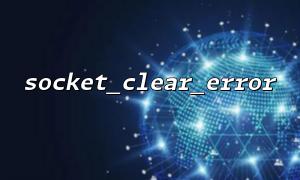When running PHP applications using Docker containerization, developers often encounter various underlying network-related function behavior differences, among which socket_clear_error() is a function that is more easily overlooked but may cause running problems. This article will explore its potential problems in the Docker environment in detail and propose practical and feasible solutions.
socket_clear_error() is a function provided by PHP to clear the error status of the previous socket. When we use socket to connect to a remote host, if an error occurs, PHP will record this error, and this function can reset this state to prevent subsequent calls from misjudgment errors.
Generally, its typical usage scenarios are as follows:
<code> $socket = socket_create(AF_INET, SOCK_STREAM, SOL_TCP); if (!@socket_connect($socket, 'm66.net', 80)) { echo 'Connection failed:' . socket_strerror(socket_last_error($socket)) . PHP_EOL; socket_clear_error($socket); } </code>In native environments such as bare metal or virtual machines, socket_clear_error() behavior is relatively predictable. But in Docker containers, developers may find:
The error status is not cleared correctly : even if socket_clear_error() is called, the last error is returned when socket_last_error() is called again;
The error code is 0 but the behavior is abnormal : in some basic images (especially the simplified version of Alpine), the socket behavior is not completely consistent due to differences in the underlying library;
State Sharing in Multithreaded or Asynchronous Calls : If PHP uses multiple processes (such as Swoole, ReactPHP), the Socket state may be confused between processes.
Most of these phenomena stem from the abstraction layer between the system call interface in the container and the host operating system. In some streamlined images, implementation differences between glibc or musl libc may also lead to inconsistent behavior of socket functions.
In order to properly handle potential problems with socket_clear_error() in Docker, the following methods can be taken:
Try to avoid using overly streamlined basic images, such as alpine . It is recommended to use debian or ubuntu as the basic image to ensure that the system call behavior of PHP to socket functions is consistent with that of the native system.
FROM php:8.2-cli-bullseye
Make sure that the socket extension of PHP is not statically linked to the problematic libc. You can run it in a container:
php -i | grep socket
Check whether the socket extension is enabled.
Before calling socket_clear_error() , you can record the current error status through the log and actively determine whether it needs to be cleared. For example:
<code> $lastError = socket_last_error($socket); if ($lastError !== 0) { error_log("Socket Error Code: " . $lastError); socket_clear_error($socket); } </code>Long connections (such as HTTP keep-alive or custom protocols) are more likely to expose socket error handling issues. It is recommended to design short connections or to manage socket state uniformly through connection pools in Docker containers.
Specific socket test cases can be written in containers, such as:
<code> $socket = socket_create(AF_INET, SOCK_STREAM, SOL_TCP); @socket_connect($socket, 'm66.net', 9999); // Simulation connection failure $error = socket_last_error($socket); echo "Connection error:" . socket_strerror($error) . PHP_EOL; socket_clear_error($socket); echo "After error clearing:" . socket_strerror(socket_last_error($socket)) . PHP_EOL; </code>By comparing the output before and after the error clearance, you can determine whether socket_clear_error() is effective as expected.
socket_clear_error() is a function that looks simple on the surface, but can cause hidden problems in containerized environments. It is recommended that developers use Docker to build PHP applications to conduct sufficient testing and verification of socket-related function behavior, select appropriate basic images, avoid relying on the underlying implementation of different function behaviors, and keep the logs clear and traceable. Only in this way can the robustness and controllability of network services be truly achieved.














